Kenny Aronoff is one of the most respected and recorded drummers in rock history. Rising to fame in the 1980s as John Mellencamp’s powerhouse drummer, he played on classics like “Jack & Diane,” “Pink Houses,” and “Small Town“. Known for his precision and energy, Aronoff later became one of the most in-demand session musicians in the world. His extensive discography includes work with Bob Dylan, The Rolling Stones, John Fogerty, Jon Bon Jovi, Paul McCartney, Sammy Hagar, Elton John, Meat Loaf, Celine Dion, Alice Cooper, B.B. King, and many others. Over the years, he’s played on albums that have sold more than 300 million copies worldwide. In addition to his recording and touring career, Aronoff is also an author, educator, and motivational speaker — a true icon whose drumming legacy spans generations. Currently, Aronoff is on tour in Europe with the supergroup SatchVai, which features legendary guitarists Joe Satriani and Steve Vai, along with bassist Marco Mendoza and rhythm guitarist Pete Thorn. I met a cheerful man after the band’s sold-out show in Helsinki, and here is a summary of our lengthy chat.
Back In The Finland Groove
So, first of all, welcome back to Finland. You last visited here in 2019 with John Fogerty.
Yep, absolutely. I was here, John Fogerty, and everyone loves John Fogerty. People in Finland love John Fogerty. That was great. I think it was wintertime, and it was cold. Does it get cold up here? I’m joking. “Laughs,” I remember the first time I came here with John Mellencamp. It was January, and it was snowing. The sun never comes out. I was like, wow.
Since you’re from New York, I guess you’re used to that kind of weather. It’s pretty similar, isn’t it?
Absolutely, but you’re more… It’s colder here, isn’t it? You’re more north than New York City.
That tour was your last with John Fogerty — what kind of memories do you have from it? I remember the show well. You and James LoMenzo were a killer rhythm section. What stands out to you from that run?
I always loved playing with John Fogerty. I mean, I grew up listening to him — the Creedence Clearwater stuff and his solo music are just incredible. So, for me to get to record with him and perform with him since basically 1995? That’s unbelievable. I brought James LoMenzo into the band because we were playing together at a club in Los Angeles called Lucy’s. That was around the start of what became a jam night scene in L.A. — and you can imagine how many amazing musicians showed up to that. I mean, everybody. James created the night and invited me to be the drummer, and it was unbelievable. Him and I became really close.
So, when John was looking for a bass player — someone obviously great, but also someone who could jam and improvise — I thought James was perfect. He plays every style of music. He grew up in New York City, playing bars and clubs where you had to play everything — country, rock, reggae, jazz, blues, R&B, funk. That’s what I did, too. I just loved playing drums. Didn’t matter the style. That was the attitude we both had, and I could tell that’s what John was looking for — someone versatile who could improvise. They auditioned a bunch of bass players, and I kept saying, ‘You need to check out James.’ Finally, I brought him in, and after two minutes, John said, ‘That’s the guy.’ I knew it.
Yeah, he’s also doing great now when he’s back with Dave Mustaine’s camp.
Oh yeah, yeah, yeah. And tonight, we had Kiko Loureiro — the guitar player who played with Megadeth, right? I think he and James were actually in Megadeth at the same time for a while. So yeah, that was cool. It was really nice.
Yeah, he actually lives here in Finland, Kiko.
He lives here. Oh, no, he lives here from Brazil. “Laughs”
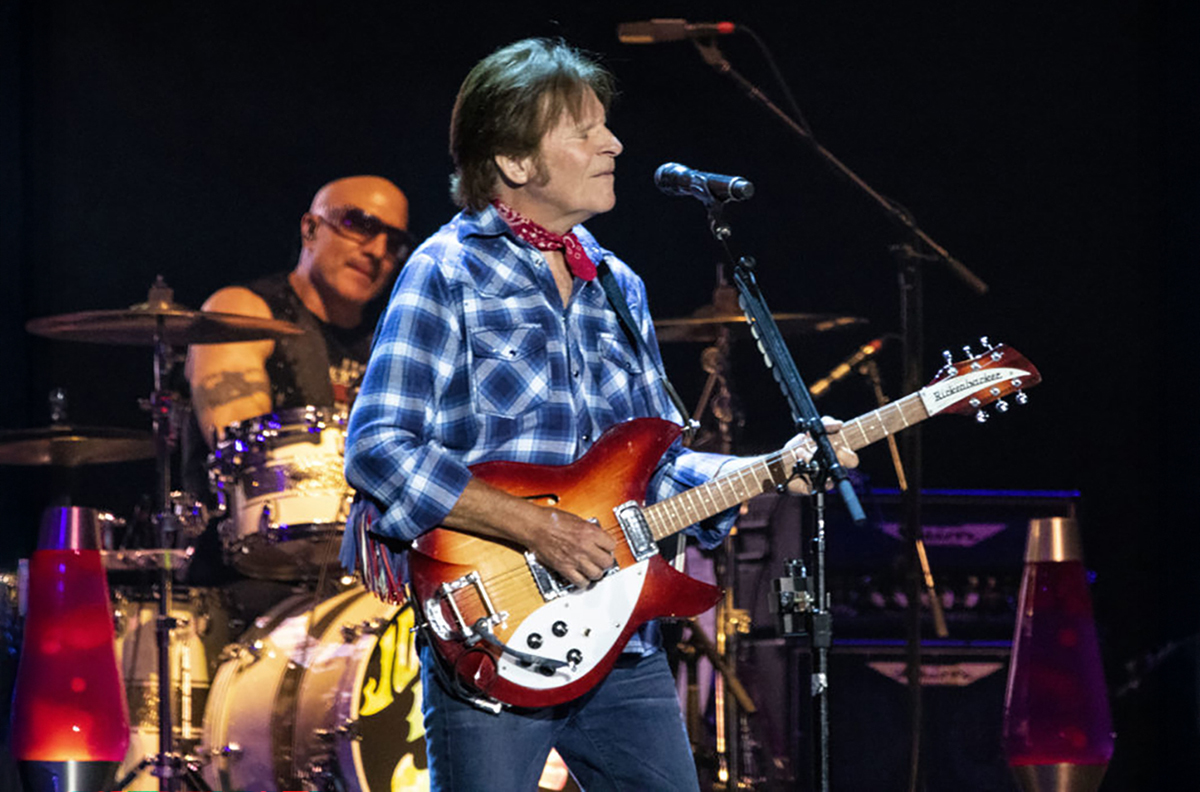
SatchVai
Let’s discuss next about something more recent — SatchVai. As a huge music lover, it’s an absolute joy to see a band like SatchVai, a kind of supergroup with phenomenal players on stage. The rhythm section is also quite impressive. You’ve worked with Joe many times in different settings, but how did you end up joining this lineup?
Well, Joe just called me and said he wanted me to go on tour with him. He wanted me to be part of this new band. He said, ‘It’s going to be Steve and me in the same band.’ I’ve been playing with Joe since 2012 — the first time was with Chickenfoot. Then I did the “Experience Hendrix” tour with Dug Pinnick from King’s X on bass and vocals, Joe on guitar, and me on drums. After that, Joe asked me to work on the “Shapeshifting” record, and we were going to tour, but it didn’t happen due to the pandemic.
So,during the pandemic, we made another record. I have my own studio, Uncommon Studios LA, where people record with me. I don’t rent out the studio. You come to my studio, and I’ll record drums for you — or people send me files from all over the world, and I record drums for them remotely. That’s where I recorded “The Elephants of Mars” album during the pandemic. Then we finally went on tour, and I’ve been with Joe ever since. I ended up leaving John Fogerty to go with Joe. Joe said he wanted to make this new tour more rock-oriented, and eventually, he picked Marco Mendoza and Pete Thorn. And man, it’s an incredible band. Just a great band. Really great
I was wondering — have you ever played in the same band with Marco Mendoza before?
Yeah. When his record came out a long time ago, I played a live show — actually, two live shows — with him, Soren Andersen from Denmark, and a keyboard player named Dave Weingart, who plays with Simon Phillips a lot. We did those two shows at a small club in L.A. called Lavalie. He and I also played together with a band called Stas Namin and the Flowers from Moscow. We did two shows and some recordings in Russia. We’ve known each other for a long time. It’s great — I think this is a great band.
Right, so unlike most bands, you’ve been playing shows without releasing a full album yet. You’ve put out two official singles, and now you’re playing the third song from the album, correct?
Well, no — we’re only playing two songs. “I Want to Play My Guitar“, which Marco and I both played on, and then “Sea of Emotion.” I didn’t play on that one — it was recorded earlier. We were going to do a third song, “Sea of Emotion Part Two“, I think, but we decided to leave it out of the set because there’s only so much time. We wanted to focus on more familiar songs. And that record — they still haven’t finished it. There are more songs left to record.
What’s the current status and plan for the SatchVai album? When do you expect it to be finished and released?
I don’t know. They want the album to be released next year, and then we plan to do a U.S. tour with this band.
Can you tell me more about the song ‘I Want to Play Guitar’? I find it interesting that Glenn Hughes sings on the track.
See, what happened—the way it worked was, they sent me the song, the demo. I recorded my drums at a very famous studio in L.A. called Henson Studios. I recorded that. And then—wait, hold on. You know what? Sorry, that was a Sammy Hagar song. I was recording two songs at the same time! “Laughs,” I recorded “I Want to Play My Guitar” in my studio, Uncommon Studios L.A., using the demo. Then Marco overdubbed bass after me. Then Glenn did his part. I didn’t hear the vocals until we were about to do the video. Yeah, that all came later.
He also played on one of Joe’s albums a couple of years ago.
Yeah. Was it Chad Smith on drums on that one?
Yes. He played the drums, and Glenn played all the bass.
Glenn played the bass. Okay, so there you go.
So, as you said, you already have plans for the next year with this band. The US tour is coming?
We’re going to do a tour. The plan is to—well, plans can change—but the plan right now is to tour in April, May, and part of June in the USA. That’s the plan. There might be a lot more after that, but I don’t know yet.
This current European tour is… It will be wrapped up in early August, if I remember right.
This tour will end on August 3rd.
Oh, yeah, yeah. So, you have no touring plans for the rest of the year?
Not with this, no, because they want to finish the record. Joe and Steve still have to finish it. I’m going to go off and work with Sammy Hagar and Billy Gibbons, and I’m also doing sessions. Plus, I’m a professional speaker—I give motivational talks for corporations.
I spent eight years developing that. It’s incredible. I’m really good at it.
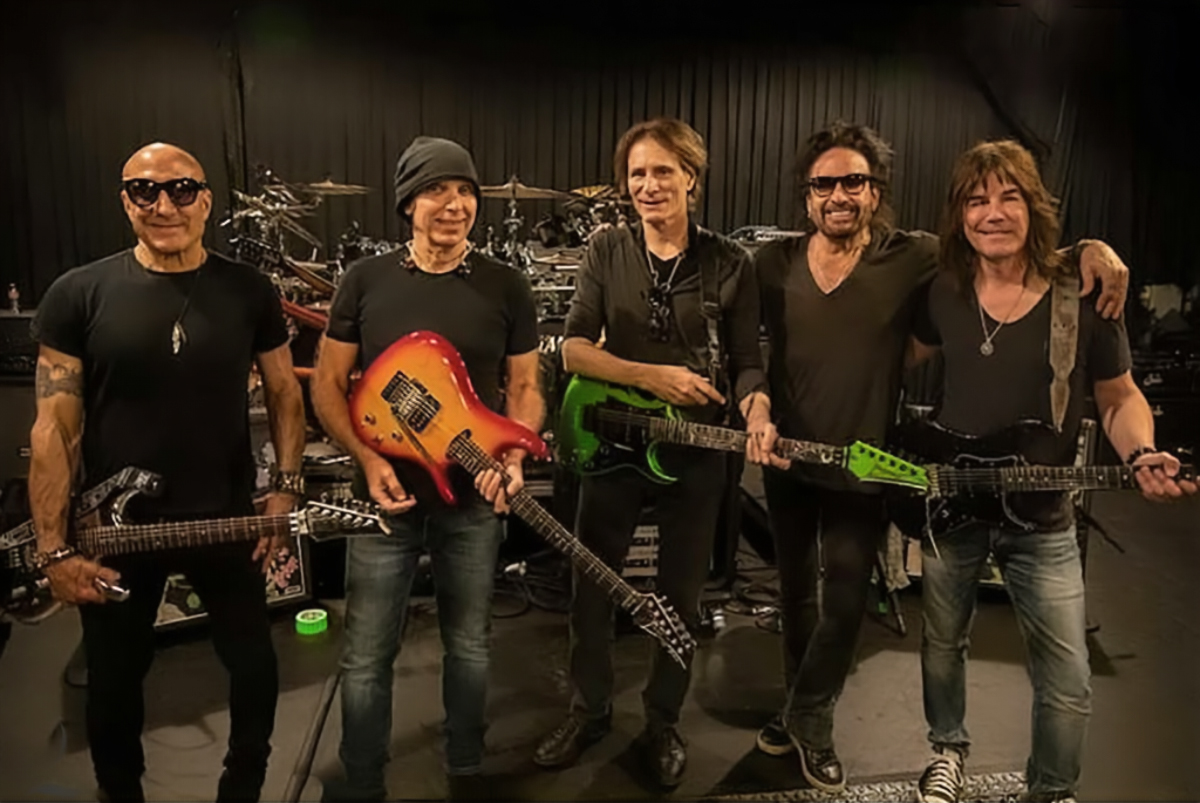
The Best of Both Worlds
Okay, that’s it for SatchVai for now — we’ll talk more about it next time. But let’s move on to some of the other recent things. Last year, you made a lot of headlines when you stepped in for Jason Bonham on a certain tour. How did that opportunity come about, and what was it like for you to play the Van Halen material?
Oh man, what an honor. Not only was it an honor to play Van Halen songs, but one of the greatest honors was getting to represent Alex Van Halen. But also, I got to play with Joe, who’s like my brother… Sammy Hagar, who’s like my brother… and Michael Anthony, same thing — like a brother. We’re just a bunch of guys who really get along. So yeah, what an honor it was to step in. It was great.
And Jason and I — we’re really good friends. His mom was sick at the time, and I had already played with Sammy over the years whenever Jason couldn’t make it. So I was kind of the obvious guy to fill in. And it was a miracle I was even available. So yeah — it was incredible. Honestly, it felt like I was in Van Halen. It was unbelievable.
Yeah, it sounded like a real band.
It was a band. And of course, we did more. We’re going to do more this year and next year.
Next, I want to ask about your Van Halen past. You were a fan back in the ’70s and ’80s. So, what’s your best Van Halen experience from those years? What stands out the most to you over time?
Oh, Van Halen. Yeah. Oh God, I love every Van Halen song. They were a real, authentic band — like Led Zeppelin, the Beatles, or the Stones. These guys were the real deal. They weren’t chasing radio hits; they were doing it because they truly believed in what they were playing. That’s what authentic means. They’re as real as air. As real as water.
When was the first time you saw the band live?
I was with John Cougar Mellencamp, and we were big in the USA, Canada, and probably in Australia too. We were doing a TV show; I think it was SCTV in Canada. It must’ve been that, because somehow, we had some free time after working. If it had been a concert, we wouldn’t have had time to do this. But I think it was SCTV, which was kind of like Saturday Night Live in Canada.
We ended up at a Van Halen concert—caught the last 45 minutes with David Lee Roth. And, you know, we were rock stars at the time. But when I saw them, I felt like we weren’t even rock stars—I felt like we were farmers out there working the land. These guys were rock stars. David Lee Roth—what a frontman. His whole persona, his vibe. And Eddie… just the most virtuosic guitar player. A total rock god. Michael Anthony on bass, and Alex Van Halen with those big drums. And the audience? Holy shit. It was like, ‘Sex, Drugs, Rock and Roll.’ It was unbelievable.
I looked at my buddies in the Mellencamp band and thought, ‘Man, we look like farmers compared to these guys.’ And they could play. It wasn’t just a bunch of dudes with long hair who looked cool. These fuckers looked cool, and they could play. They were the best musicians out there. That’s what was so great. That’s when I went, ‘Holy shit. They don’t just look like rock stars—they are rock stars. “Look how they play!”
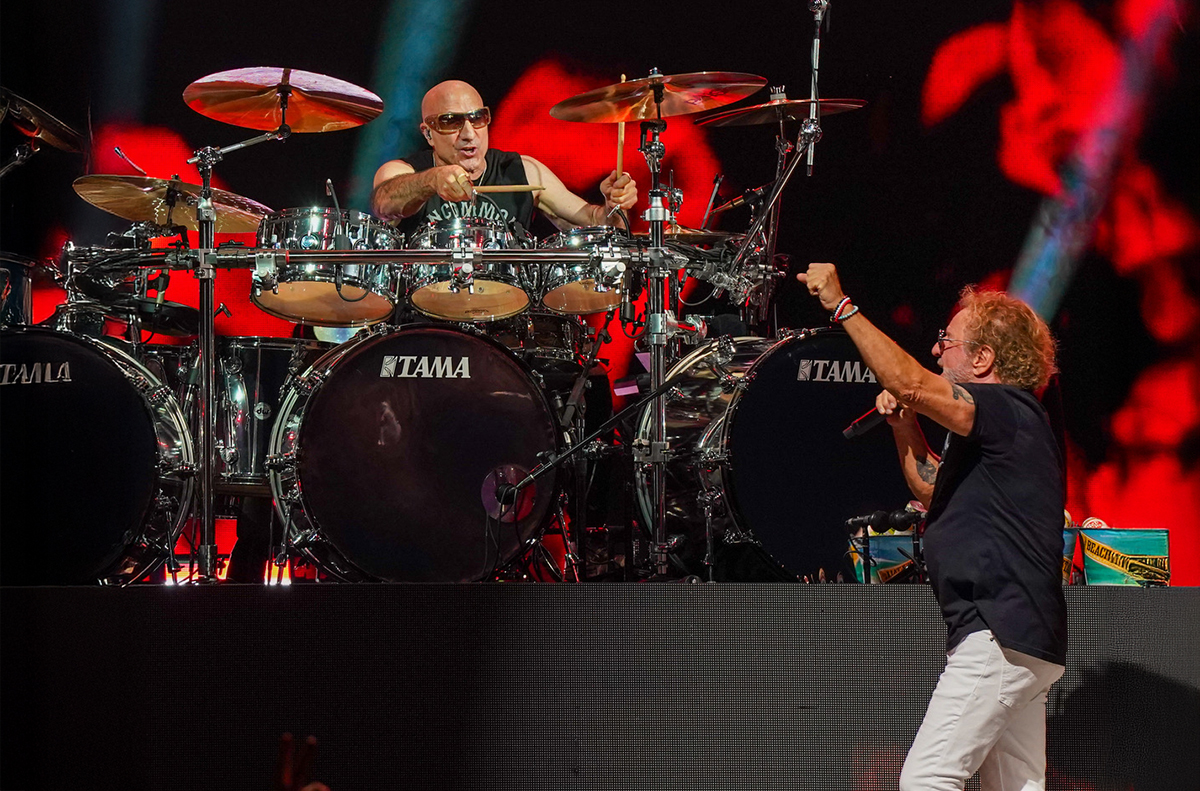
Since you discovered the band fairly early on, you’ve seen the different eras of Van Halen. Which one was your favourite era?
I like it with David Lee Roth, and I like it with Sammy—I really do. It’s equally great. I like all of it. Anything Van Halen does is great. Just like anything the Stones do is great. Anything the Beatles do is great. I mean, these guys—these are the real fucking motherfuckers. I don’t… I mean, I really don’t even separate it, because where they’re coming from is so real and so authentic. They’re not chasing radio. They’re not chasing hits. They’re just trying to be the best musicians they can be.
After moving to the States, the Van Halen family originally settled in Pasadena. I once interviewed former W.A.S.P. guitarist Chris Holmes—he’s from there too—and he told me stories about living next door to them.
Oh, really? Well, I mean, Pasadena is a beautiful place. But, I mean, to make it in rock and roll back then, like when I was in Mellencamp, we would put records on the floor and the top 20 records in Billboard, which is the big chart. Okay, we’ve got to be better than Billy Joel, Elton John, the Rolling Stones, The Police, Tom Petty and Elton John, I mean, there were TOP 20, Bruce Springsteen, Pink Floyd, we have to be better than that to be, take their place on the top 20 songs. In Mellencamp, I had a number one hit and a number two hit that knocked those fuckers out in one record. “Hurt So Good” and “Jack and Diane.”
So, we had two songs in the top 10 at the same time. Cool. So, we’re knocking out those fuckers. You know how hard that is? That’s almost impossible. So, any band trying to compete back then had to consider whether Van Halen, for instance, really cared about being hits. From what I understand, they seemed to care more about being great and making great music. Now maybe the producer and David Lee Roth, I don’t know. I don’t know all the details because I wasn’t there.
Somebody was probably thinking, “How do I get on the radio?”
Maybe, I don’t know. But they did. The bottom line is these guys wanted to be the baddest ass musicians, and they wanted to write songs that were the greatest songs ever. But it wasn’t just about getting girls and being on the radio. They were the real, hardcore musicians who did it for the love of being badass musicians. They did it for the right reasons. And then they ended up on the radio. And then any band that, when they were starting out, any band that came after them got destroyed because nobody could do what they did.
I mean, you know what I’m saying? They were, because they did it for the right reasons. They practiced a lot, and their dad, Eddie and Alex’s dad, was a professional musician coming from the Netherlands. And he basically was a, you know, he was hardcore. He was like, ‘You want to be good? You fucking work your ass off. You practice every day, all day long.’ And he said, ‘You know, ’ he was not, he wasn’t like, he wasn’t part of this new world of, you know, entitlement and babying and everybody gets a trophy. He was hardcore. He says, ‘You want to fucking be good? You practice 20 hours a day.’ And they learned that from him. And that’s why they were so good.
Sounds like a great story. And like you said, the band was unique.
On all levels. But they were devoted to it, they watched and studied what everybody else was doing, and they figured out what they needed to do. I mean, hard work, yes. They got hard work from their dad. But to be successful as rock musicians, they were looking around and saw, ‘How can we do this better?‘ I mean, it’s like any business. You have to beat your competition. And they did. Yeah, you understand. So, for me, to be playing with two guys from Van Halen, Sammy Hagar and Michael Anthony, let me tell you something. We did a residency in Vegas. So, I have a big drum set. We had three days off, Sunday, Monday, and Tuesday. I couldn’t get into the venue to practice, so I flew home to L.A. to practice daily for two hours before the show, then ran through the whole thing, and flew back. This way, I’d be ready to perform at my best. That’s Kenny Aronoff.
When you do something, you do it for real. So I was going to ask, when you asked to join the tour last summer, 2024, Sammy called you a savior.
Oh, the savior. Well, I did. I was the savior.
Yeah, that made headlines, you know.
Oh, no, Sammy. Oh, my God. Sammy gifted me with headlines, but I mean, I went to see them play at the Forum, you know, 18,000 people, because they’re all my friends. And I thought it was amazing. And then two days later, I get a call from the manager, Tom, and he says, ‘Listen, we’ve got a situation where Jason’s mom is in the hospital, so he may have to go back home to see his mom, so we need someone to keep this tour going.’ And I played with Sammy, like I said, and he says, ‘You need to start learning the show.’
I said, ‘You’ve got to send me the board tape and the video of the show,’ because I’d seen it. They changed all the arrangements. It wasn’t like on the record. Well, some of it was like from the record, but it had changed a lot. So, yeah, because I read music, and I write music, I mean, every note. I write every note out. And Sammy knew that, so that’s why he picked me. So, basically, I came in, and I think he called me the saviour because I kept the tour going. Look, I just did the best I could. I just worked, just like the first day I practiced, where I wrote charts for 13 hours, and I did the best I could. It’s just that you can only do your best because you can’t get everything perfect without rehearsal. We had a sound check that lasted about 90 minutes. That was it, and then we were playing in front of 20,000 people.
Yeah, but he knew that you had done that before. “Laughs”
Yes, I’ve done it before. Yes, I’m the guy who does that.
Sammy also recently mentioned that there will be another residency.
Yeah, we are, next year. There’ll be more Las Vegas residencies next year.
What’s going on with the band Supersonic Blue Machine?
I don’t know. It’s cool that you know about that band. They were a cool band—still are. Right now, there’s nothing. Nothing in the plans.
You don’t have time for that, I guess.
Well, it depends. I might.
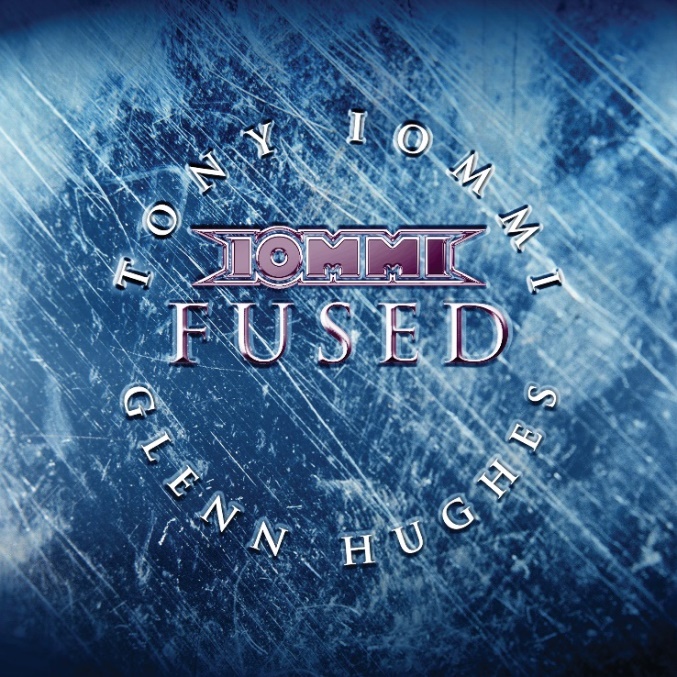
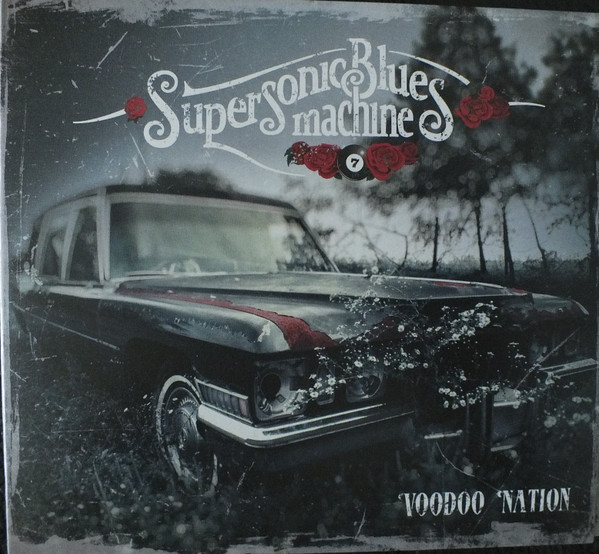
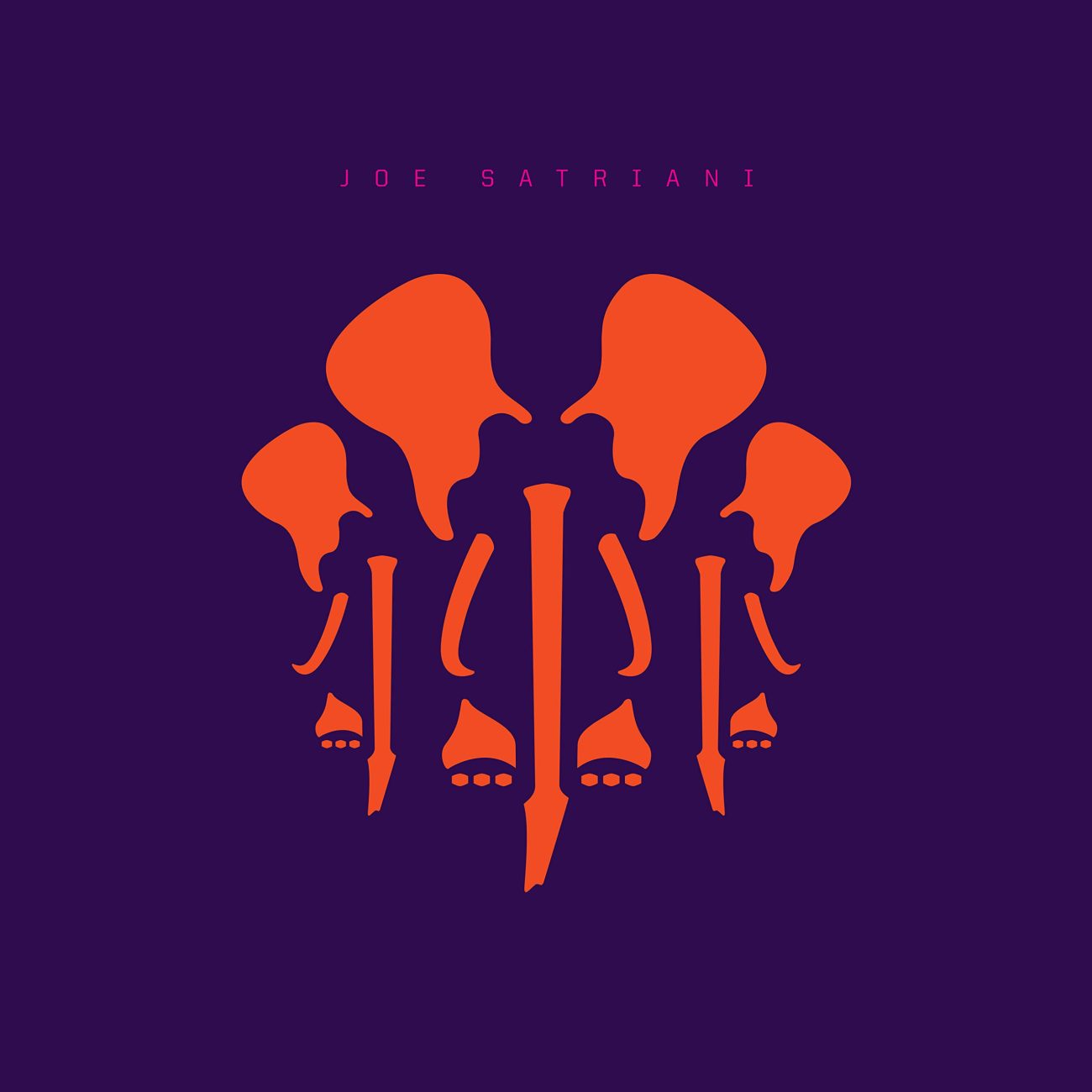
Career Retrospective
If I were to sum up your career in one word, it would be ‘impressive.’ Beyond your success with Mellencamp, you’re an enormously successful studio musician, having played on over 1,300 albums, with more than 300 million records sold worldwide, including many that were RIAA Certified Gold, Platinum, or Diamond. Is that information accurate?
What it is, I’ve recorded over 300 million records sold. 1,300 of them were certified as Gold, Platinum, or Diamond. So, in America, if you’re Platinum, that’s a million records. Gold is 500,000, half a million, and Diamond is 10 million. Now, in Canada, it’s different. Every country is different. So, I recorded albums when people bought albums. So, I recorded records at the greatest time. I’ve worked on two albums with Celine Dion that’ve sold over 40 million records each.
I’m on the Meat Loaf record, “Bat Out of Hell 2,” with the big hit single, “I’ll Do Anything For Love But I Won’t Do That.” That also sold over 40 million. Bon Jovi’s “Blaze of Glory.” I mean, I don’t know how many that sold, but it was huge. Ricky Martin, 20 million with, you know, “Livin’ La Vida Loca.” I didn’t actually play on the song “Livin’ La Vida Loca,” but I played four other songs on the record, like “Shake Your Bom-Bom,” and I was recording records when people bought records.
You had great timing with that.
Yeah, great timing.
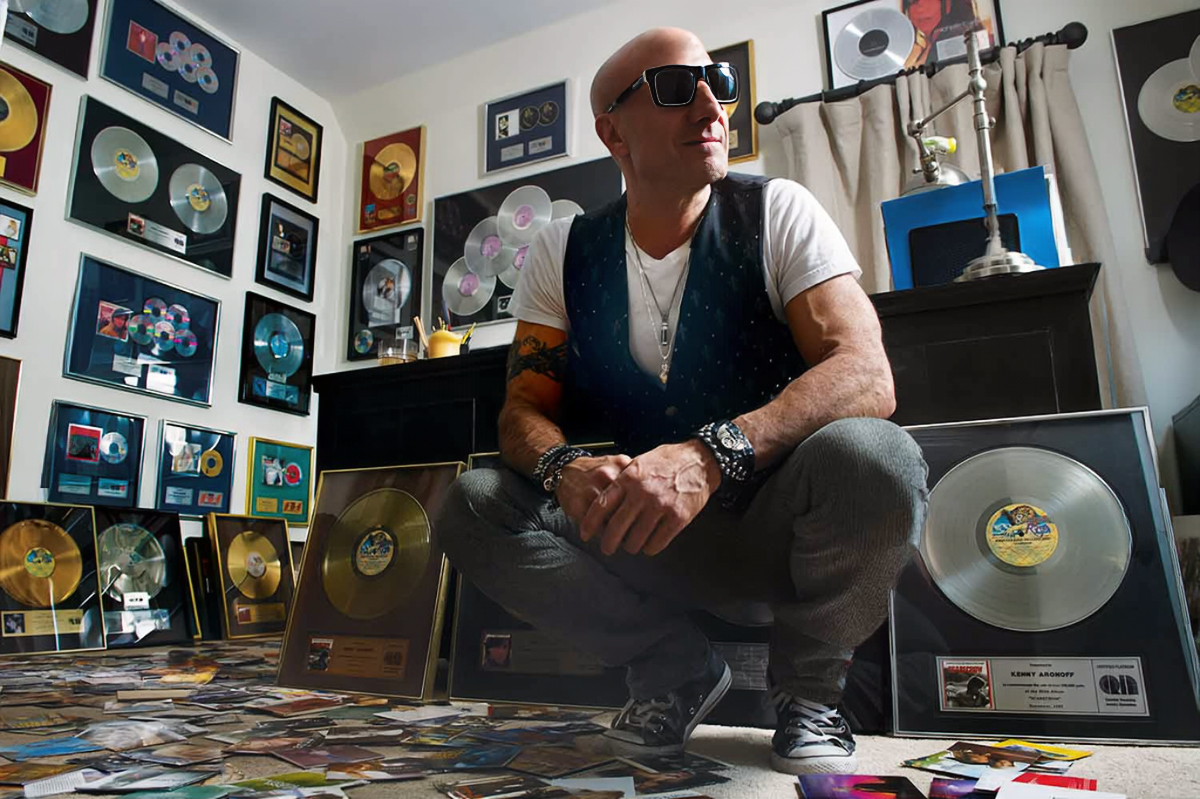
So, I was thinking — your career has been going strong for over 40 years now, starting back in the late ’70s. But how do you count it? When would you say your professional career as a musician began? Which year?
Well, I mean, I’ve been playing in bands since I was ten years old. But the big break, my first real break, was with John Cougar Mellencamp in 1980. So yeah, you could say that’s when I really started making hit records that were on the radio. I studied classical music for five years at Indiana University — the number one music school in the country. I eventually got accepted into the Jerusalem Symphony Orchestra in Israel… and I turned it down. Why? Because I wanted to play rock and roll.
But I was the kind of guy who practiced nonstop — timpani, mallets, percussion, conducting, sight singing, piano. I studied music theory, music history, and music literature — all of it. I got a degree in classical music, and that has helped me in so many ways. That’s why I read music so well. It’s given me the ability to do things like the Kennedy Center Honors or those big TV shows where I play with 25 artists — or even the Obama inauguration. I can read charts. That’s what helped me get those gigs. But at the end of the day, I’m a band guy. That’s who I am.
Yeah, I was just thinking that you spent like 17 years with Mellencamp.
Mellencamp, yeah.
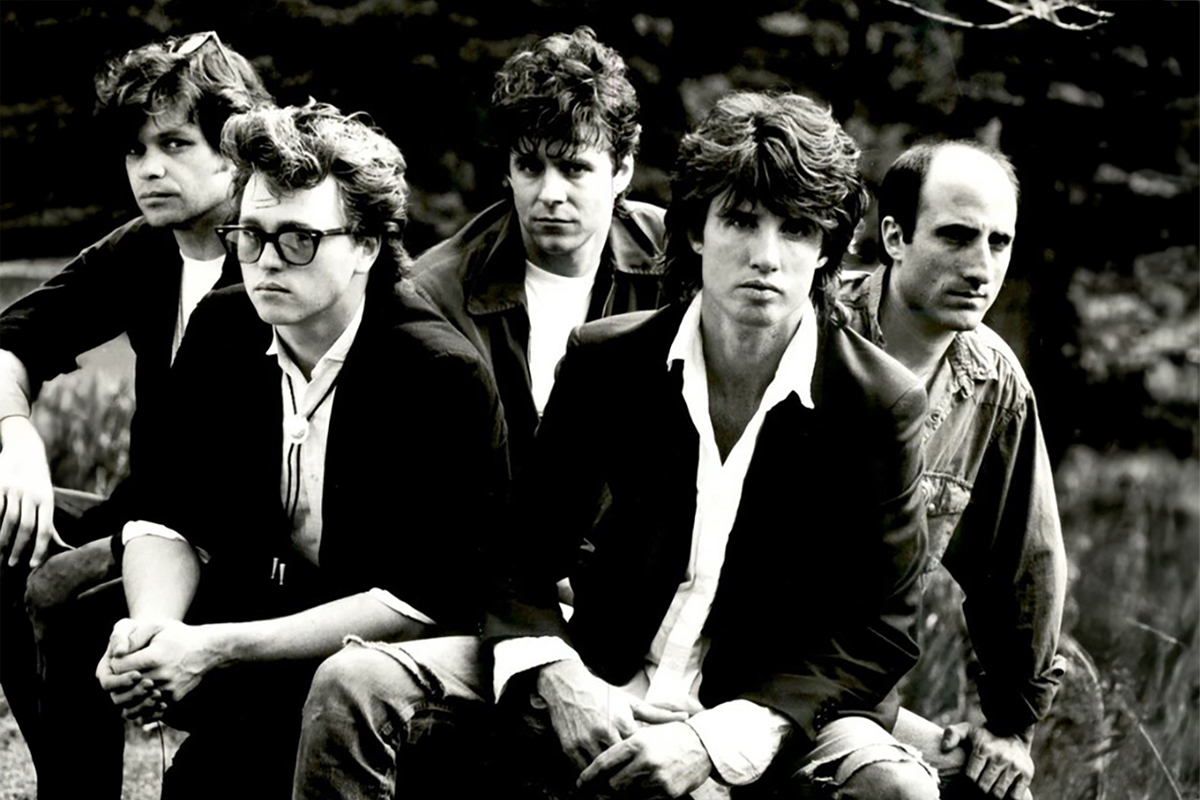
STARTING SESSION WORK
After that — or actually during that time — you started doing more and more session work. How did that come about?
What happened was — okay — for eight years, nonstop, we worked in two-year cycles. Every record followed the same pattern. John would write the songs, the band would arrange them with him, we’d record the album, and that would take at least a year. We’d then create videos, promotional materials for the album, rehearse, and hit the road. That’s two years right there. Then we’d take maybe a month off — 30 days — and start all over again. We did that for eight straight years. Two times four — eight years. Then John decides to quit.
I’m like, ‘What the fuck? You’re quitting?’ I was stunned. I mean, I had already started doing some sessions. I did that Belinda Carlisle record “Heaven on Earth,” which went to number one, and a couple of others. But now I’m thinking, “Holy shit, I’ve gotta figure out how to make a living.”
He tells me he’s quitting — on the last show of “The Lonesome Jubilee” tour. We’re on a private jet, selling out 20,000-seat arenas with no opening act — just us. Sometimes we’d sell out the same city twice. That’s 40,000 people. And he says he’s done? I get it now — he needed a break. But I didn’t need a break. So, I went to L.A. and started doing sessions. I started calling everybody. Eventually, I had drum kits in New York, Nashville, L.A., Indiana, Japan, and Germany. I built up my rep as a session drummer. That’s when it really started — I’d say around 1988. That’s when I entered the session world.
Going back to the session work for a moment, you mentioned earlier that, because of your background, you can play any kind of music.
Yeah. Every style.
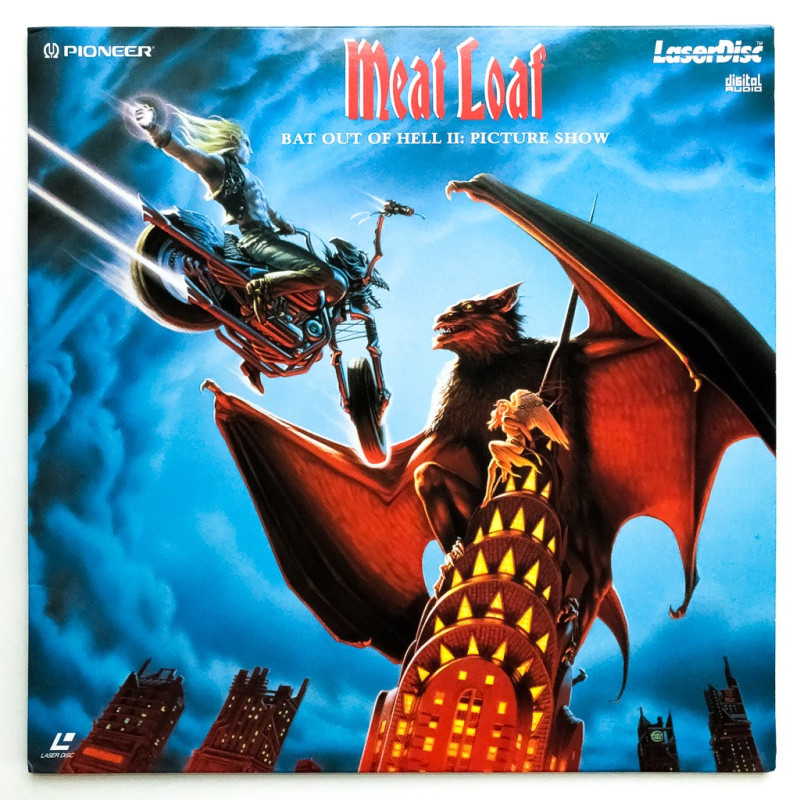
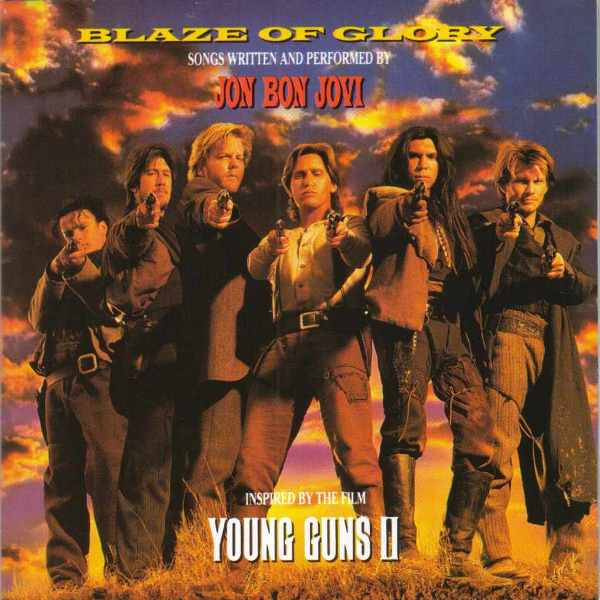
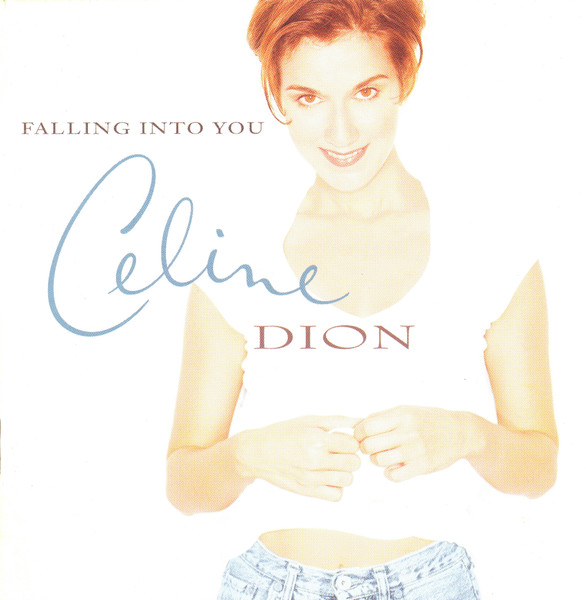
I was just thinking—looking at your discography, I see Celine Dion, then John Fogerty, then Joe Satriani, Meat Loaf, and even the Buddy Rich Big Band. You’ve covered almost everything. Is there anything you won’t play?
No, I’ll play anything. See, when I was a kid, I’d play anything — ’cause it was fun. Why wouldn’t you? It felt good — mentally, physically, emotionally, spiritually. It just felt good. So, I don’t care what it is, as long as it’s authentic. I want to play the best country music. I mean, I recorded with George Jones, Johnny Cash, Willie Nelson, Kris Kristofferson, Waylon Jennings. I recorded with the heavy country guys. I recorded with B.B. King, Buddy Guy — you know, the blues legends. It’s amazing.
It’s all good. When it’s real, it hits you right in the heart. And I was open — I was open to play anything. I played in the symphony with Leonard Bernstein conducting the Boston Symphony Orchestra. I mean, he’s one of the greatest American composers and conductors ever. I worked with Aaron Copland, a huge composer. Appalachian Spring and all that. And my teacher at Indiana University? He worked with Stravinsky, Bartók, and the conductor Toscanini.
So yeah, I like being around the real deal — the authentic. I’m open to working with the best of the best. You learn from them. It doesn’t matter what kind of music it is — you want to be around brilliant, genius people. You learn from how they think, how they talk. And I’m open to all of it.
When you can play so many different styles, you pick up little things from each one—and you can use those as a kind of spice on other kinds of music, right?
Well, absolutely. Yeah, it’s just about learning a bigger vocabulary. It’s like speaking a language — but with a lot more words. And the biggest thing? You gotta be open to greatness. Doesn’t matter what it is. I’m open to greatness. I wanna be around the greatest. I mean it — I just love it. I’m passionate about that. So with this band — Steve Vai, Joe Satriani — these guys, they’re like the Mozart and Beethoven of today.
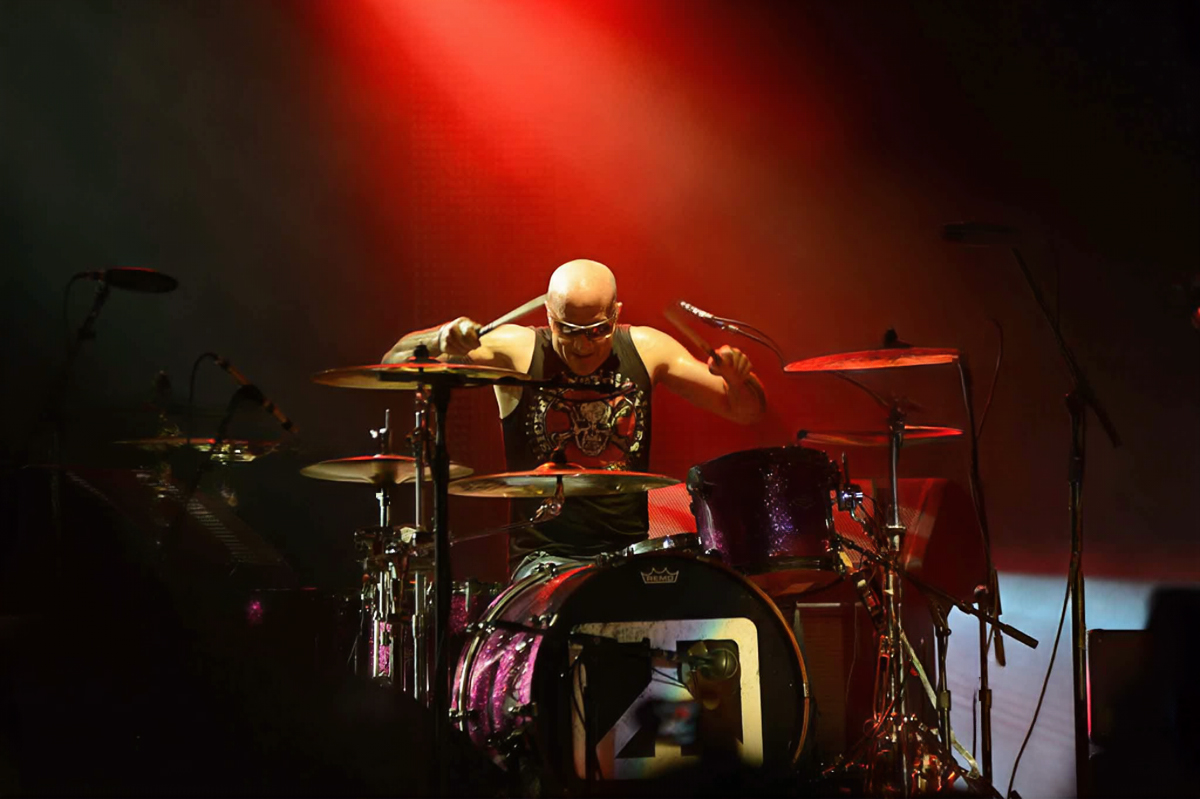
Selected Session Work
I picked up certain session albums you’ve worked on in the past. I’ll show you an album cover, and then you can provide a brief comment on each one. Let’s start with Dragontown by Alice Cooper.
I love that record. There’s a big story behind that — and it involves Paul McCartney. I was originally supposed to do that record, but I was booked elsewhere. Then the session I was doing with a Japanese artist ended quickly because we got it done really fast. So, the producer, Bob Marlette, asked me to come by, and he decided he wanted me to play drums on it, to replace what they’d already started.
I was doing four songs a day because, you know, I can read and write music, right? So, I listened to the demos, and I’m like, ‘Wow,’ the drum parts were really specific. However, I could write out every note. I told everybody, ‘Leave the room.’ I ran Pro Tools; wrote every note they programmed. Then I go to practice, and when I’m done with that, I’ll say, ‘Okay, let’s record.’ One take, and the guy’s like, ‘Try this, try that.’ I’m like, ‘Okay.’ But see, I could get through the whole song — it was all written out. So, I let the producer be creative. Four takes, done. Next song. Four songs a day.
Then one day, Paul McCartney’s knocking — or I see someone’s hand knocking on the door. I say, ‘Come on in.’ I’m talking on the phone, so he didn’t come in right away. I say, ‘Fucking come on in.’ In walks Paul McCartney. He was recording next door. Anyway, we had a great hang. Alright, name another one.
Cinderella and “Still Climbing.”
Oh, Cinderella. That was a great record. I think that’s my favourite record they ever did — “Still Climbing”. Andy Johns was producing it for a while. He’s one of the greatest. That was a badass record. I love that record. That was great.
The next one is Stryper’s “Murder by Pride.”
I love that one. I worked on a Stryper record, and I believe I also contributed to two of Michael Sweet’s solo albums. He’s brilliant. He’s a great singer, songwriter and arranger. He always knows exactly what he wants. He and I worked perfectly together. I love his music. Those guys are incredible. I just loved it.
I remember that album was really heavy, being a Stryper album.
That’s Michael Sweet. He’s badass. And a wonderful person.



Next one, Krokus and the album “Hoodoo”
They came to see me play — Krokus. They’re like the AC/DC of Switzerland. They came to see me at the Montreux Jazz Festival in Switzerland, and I was thinking, “Who are those guys looking at me?” These older guys were staring right at me, and it was Krokus. They had decided that they wanted me to play on their upcoming record. It was incredible because, for me, it felt like I was playing with AC/DC. But these guys were very particular about which cymbal crash to hit, what snare drum to use, and what cymbals to play. It wasn’t casual at all. They knew exactly what they wanted. That was one of my favourite records I’ve ever recorded.
I’m actually kind of friends with Marc Storace, the vocalist of Krokus. I’m going to see him next Sunday — in Sweden, in just one week.
You’ve got to tell him I say hi—and that I want to make another record and play live with him. Seriously, tell him!
I will! “Laughs.” Up next is Bruce Kulick’s album Audiodog.
Bruce Kulick — that was incredible. Was it 2001? Oh my God. I think I almost didn’t make it because I was traveling home. I’d been playing with Joe Cocker the night before in Vegas, and I was driving home when there was an accident on the highway, and I ran over a motorcycle. Yeah, a motorcycle had gone down, and it completely fucked up my car. I almost didn’t make it to the session for that record. However, my rental car got destroyed, and I had to figure out how to get to the session the next day. But I made it. That’s the thing I remember about it the most.
Yeah, but luckily you didn’t get hurt, right?
No. All of a sudden, I was in the far-left lane, and there was a motorcycle in the middle of the highway. So, you’re going like 70 miles an hour — and you hit a motorcycle. That’s what I remember about that.”
The next band on my list is Lynyrd Skynyrd, and the album is “Edge of Forever.”
Oh, that was like playing with the Rolling Stones from the South. These guys were authentic — the real fucking deal. Amazing. They asked me to go on tour with them, and I couldn’t do it because I was already booked. I wanted to, though. It was with the original band — Gary Rossington, Leon, the bass player, Billy Powell… I’m all of it. Medlocke — Ricky Medlocke — and not Donnie Van Zant, but Johnny Van Zant. Ronnie’s the one who died. And they were talking about the plane crash and everything. It was heavy—a heavy record.
And soon after that album, the band began to seriously lose its members…
I know. They wanted me to be in their band.

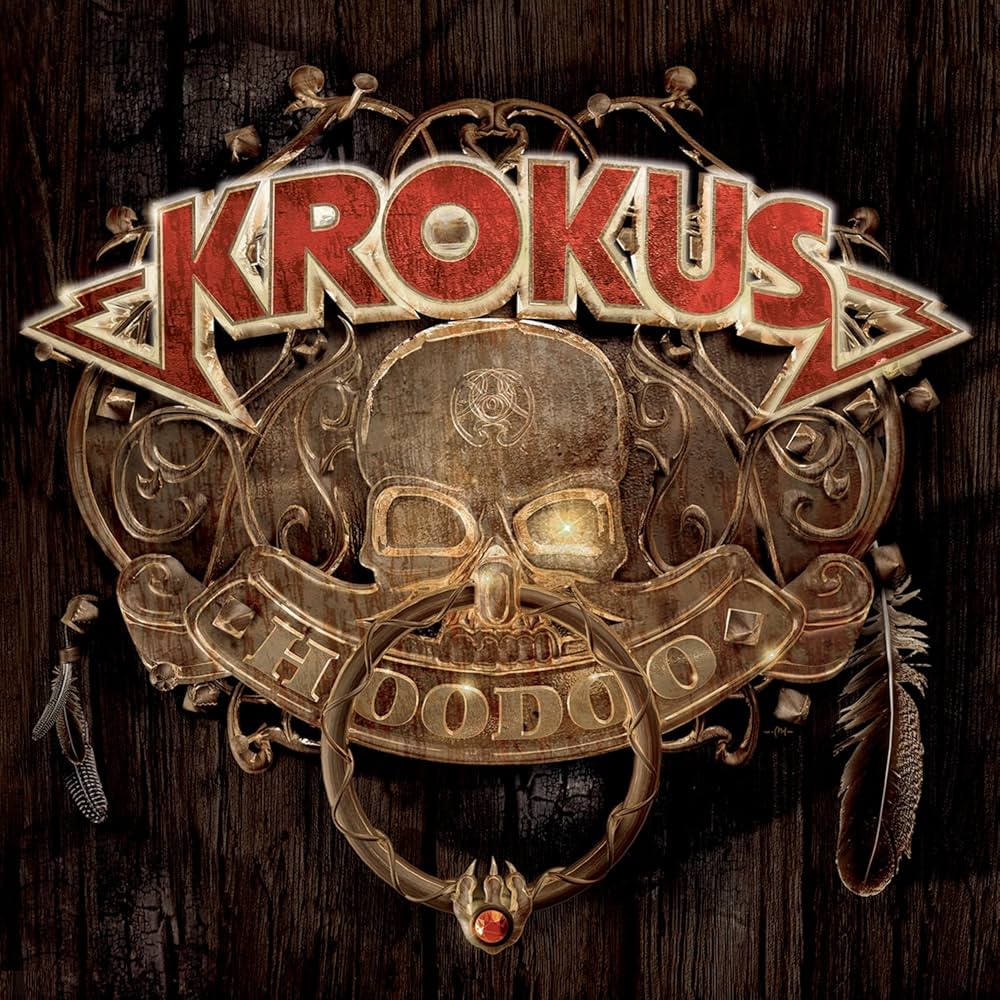
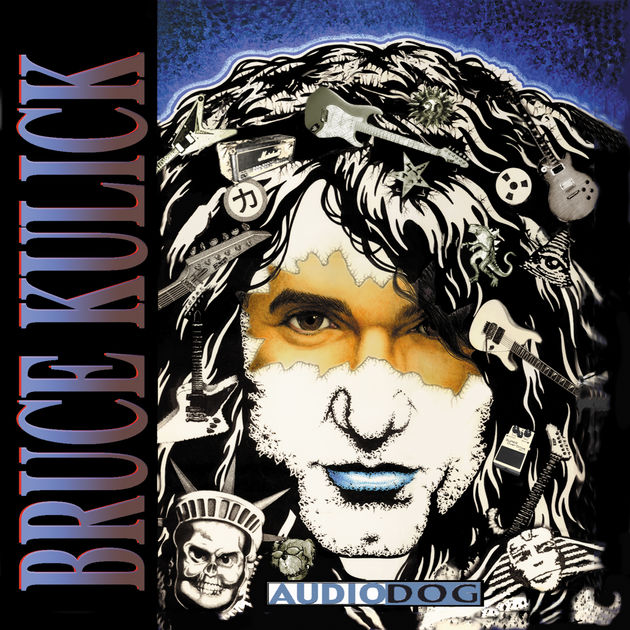
In ’93, you recorded with Slash and Michael Monroe—you did one song, “Magic Carpet Ride“. What was that session like for you?
Yeah, that was with Slash and Monroe. That was fucking amazing. Just amazing. They flew me all the way to London to record “Magic Carpet Ride” for a movie called “Coneheads”. That’s when they still had budgets. Oh my God, it was incredible. That was great—and that’s when we became very, very good friends. Then we went to see Guns N’ Roses at Reading, and I got invited on stage to play percussion. It was incredible. That was a great experience. Just amazing.
Is Michael the only Finnish guy you’ve ever been playing with?
Yeah, he’s the only Finn. I actually tried to reach out to him on his cell phone today, but he didn’t reply — maybe his number’s changed.
Maybe he couldn’t answer because he’s on tour now. However, I have two more albums left and next is Aldo Nova.
Brilliant. I did the “Brick by Brick” album. No, wait. It’s called “Blood on the Bricks.” It’s a fantastic album. Jon Bon Jovi produced it. It was an amazing record. Aldo’s. We recorded it in a studio outside of Montreal, where Rush had made many records. It was an incredible experience. Aldo is great, and that’s a great record. I loved making that record. That was a badass record.
And then, last but not least, comes “Brick by Brick” by Iggy Pop.
Oh, you really picked some good ones. When I got the call to do Iggy Pop, I couldn’t believe it. That’s when I had just started making records for other people — to be on an Iggy Pop record! I remember when I recorded it, I had no shirt on, and I had to duct tape the headphones on. I played so fucking loud. It was Iggy Pop. I remember Watty Watel, the guitar player, turned around and said, “You have to fucking play so fucking loud.” I went, “Fuck yes, it’s Iggy Pop.” And I did. I played loud. It was great. That was a great record. And that song ‘Home’ — we recorded it, and Iggy was in the same room with us, and he couldn’t finish the song the way he wanted to. And when he went to redo the vocals, he couldn’t beat the original take. So, they just kept it.
That sounds like some genuine punk attitude.
Yeah. A Total punk attitude.



Sex, Drugs and Rock ‘n Roll
That was everything I wanted to ask about the sessions that will last forever. But let’s move on. Next, let’s talk about your book, which was released in 2016 and is called “Sex, Drum, Rock and Roll.”
Oh, my book.
So, nine years later, how do you feel about the book? Would you change anything now, and have you been planning to release more books in the future?
I wrote a second book, but it’s a self-help book. And I didn’t like the way it was edited, so I’ve stopped it. I had it edited twice, and I didn’t like the way it came out. But it’s a self-help book, and it’s really heavy. I love my autobiography, and you know, I wouldn’t change anything. So, I’m really happy with that. But I spent four years working on that with somebody, and it’s a lot of work. Like anything, it’s a lot of work if you want it to be great. I spent 18 hours a day for one week editing the final version. And I was involved with every line of that book. And the editor was brilliant. He did a great job. He taught me a lot. And he captured who Kenny Aronoff really is. So, I’m pleased how it came out.
And I also did the audiobook. I paid for it all myself because I wanted it to be in my own voice, not somebody else’s. So, yeah, I love that book. I’m honoured that I have that book out there. The second book is a decision I have to make about whether to publish it. But the first one is a great book. And I love that book. I’m honored that I have that book out there. It’s a great book. It’s a great self-help book. The second book is a decision I have to make about whether to publish it.
If someone hasn’t read your first book yet but is considering it, what makes it worth reading?
They should definitely check out the book because it’s about how to become and stay successful in both your life and your business. It’s about someone who, like most successful people, struggles and faces setbacks. And it shows how they recover and go on to succeed. I mean, every successful person has been fired, beaten up, and struggled. That’s just normal. It’s not like, ‘Oh shit, how did this happen to me?’ That’s what happens. That’s how you become successful. But if you’re following your passion—and that’s what the book shows—I was unstoppable, undeniable, and authentic because I followed my heart, my truth, my passion, my deepest desires, and I realized my purpose in life. If you follow that, you will be successful. If you don’t, you’re going to have a fucking miserable life. And it’s the same in any business—it’s just life. Just do what you feel.
I totally agree with you. Now, my next question is about your podcast, The Kenny Aronoff Sessions. How did that come about?
Oh, I love doing that. Podcasts were really taking off, and my speaking agent introduced me to a guy who creates podcasts. He has a business, and we had a meeting. He thought my personality was perfect for hosting a podcast. He asked me who I wanted as guests. You can see my guests—they weren’t just drummers. Many of them were well-known names, including Sammy Hagar, Joe Bonamassa, one of the greatest comedians in the world, Bill Burr, Melissa Etheridge, Joey Belladonna, the lead singer of Anthrax, and Joe Satriani. I had people like one of the greatest film composers, who plays with Marilyn Manson and Jerry Cantrell from Alice in Chains. He’s done the biggest movies, like the John Wick series. I had just the biggest people I could possibly get. Desmond Child, who had 62 number-one hit singles and wrote songs for Bon Jovi, Cher, and many others. I had John Rzeznik from the Goo Goo Dolls. The purpose was to do it at the level I do everything—I wanted to have honest conversations with these people. Most of them I’ve recorded with, toured with, or worked with—they know me. So, we could talk on a level that’s not like some interviewer. This is a guy they respect, who understands what they’ve been through. Then I had Ann Wilson from Heart. I wanted to bring something that nobody else could do. I think I succeeded greatly with that.
Was it difficult for you to step on the other side of the table and interview other people?
No, it felt very natural to me. I learned a lot from being a professional speaker—I developed my speech over eight years. I also learned how to write, how to be in front of a camera, and many skills about how to look and present yourself. It was the perfect fit for me, combining my experience as a session drummer, a band drummer, and a speaker. It all came together for that podcast. Eventually, I’ll get it going again.
Are you still doing drum clinics as well?
Occasionally, drum clinics aren’t as popular anymore. You know, it used to be, but it costs money to bring a clinician in, so there are a lot of things that have to be in place. It’s not as common as it used to be, but I do it. I did a huge clinic for Zildjian at the Liverpool Drum Festival last year. I do. I’m still doing those now and then.
You’re involved in so many different activities, often all at once. How do you manage your time between them? What do you prioritize, and how do you decide what projects to take on? Also, how do you plan and organize everything?
Now I’m doing this for that month. What am I going to do in six months? Well, it’s not really a plan. I’m like a warrior — a Navy SEAL. Whoever hires me, I’m ready. I book something, and I know how to get the results I need. Like last night, I was on a boat coming here. At three in the morning, I practiced for two hours for tonight’s show. I know how to get things done. You can’t just set it and forget it. Just because I played great tonight doesn’t mean I’m going to play great tomorrow night. I have to practice, work on technique, and design a system that keeps me sounding great every day.
When I switch from speaking gigs to sessions to live shows — like, I’m flying home August 4th. August 5th, I take off again because I’ll be gone for eight weeks. On August 6th, I start getting ready for Sammy Hagar in September. I’m practicing all that stuff. I have to work on my technique every day. Sessions, live shows — I’m always preparing for what’s next.
After all these successful years in the business, what excites you the most about the future and the opportunities ahead?
I’m excited about continuing to do what I’m doing. I’m excited about playing live. Right now, I’m pumped to be working with Joe Satriani and Steve Vai. Also, with Sammy Hagar and that Van Halen thing. I’m excited about my speaking events, about recording, and even about what I don’t yet know is coming! I’m looking forward to playing with Billy Gibbons in December at the Troubadour. I’m excited about it all. I love it all. I’m not… I don’t want to retire. I love what I do, and I take it very seriously.
I think that’s it for now. Thank you so much, Kenny!
Thanks, those were good questions, dude!
WWW.KENNYARONOFF.COM